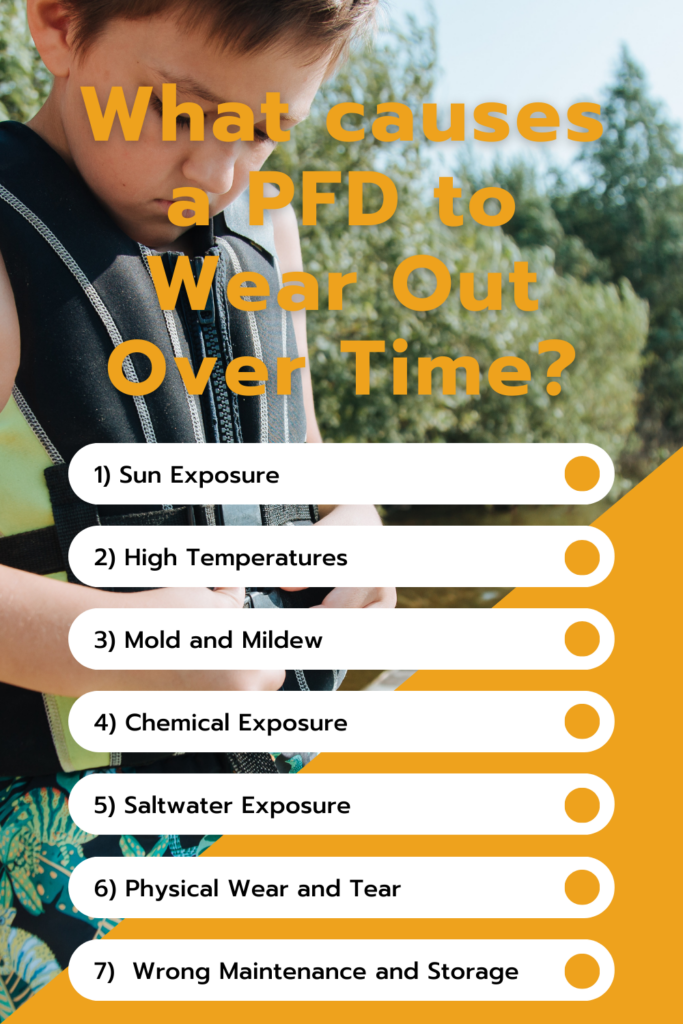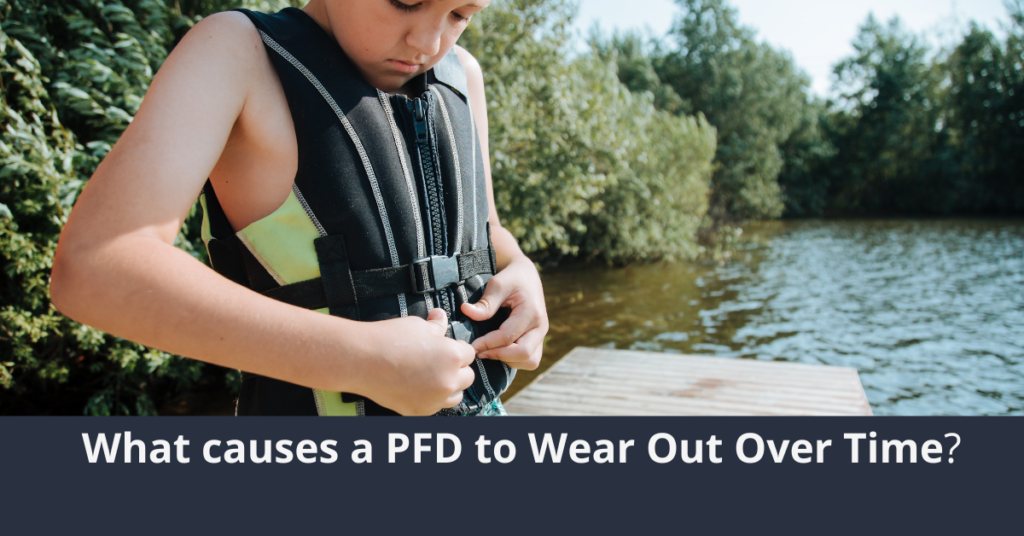Persönliche Schwimmhilfen, auch PFDs genannt, sind ein unverzichtbares Hilfsmittel für alle Aktivitäten im Wasser. Die Hauptaufgabe dieser Geräte besteht darin, den Benutzer im Notfall über Wasser zu halten. PFDs sind jedoch nicht dafür ausgelegt, ewig zu halten. Im Laufe der Zeit können PFDs aufgrund von Umwelteinflüssen und falscher Verwendung oder Wartung verschleißen. In diesem Artikel werden wir die verschiedenen Ursachen für die Abnutzung von PFDs untersuchen und zeigen, wie man sie verhindern kann.
Alles, was Sie hier lernen werden
- Was führt dazu, dass sich ein PFD mit der Zeit abnutzt?
- Wie man seine Schwimmweste richtig pflegt, damit sie lange hält
- Was ist zu tun, wenn das Außenmaterial des PFD einen Riss hat?
- Verfallen Rettungswesten?
- Wann sollte eine Schwimmweste ausrangiert und ersetzt werden?
- Schlussfolgerung: Warum nutzt sich ein PFD mit der Zeit ab?
Was führt dazu, dass sich ein PFD mit der Zeit abnutzt?
Was führt dazu, dass sich ein PFD mit der Zeit abnutzt? - Diese 7 Faktoren führen dazu, dass sich ein PFD mit der Zeit abnutzt: Sonneneinstrahlung, hohe Temperaturen, Schimmel, chemische Einflüsse, Salzwasser, physische Abnutzung, falsche Pflege und Lagerung.
#1 Sonnenexposition

Der häufigste Verschleiß von Schwimmwesten ist die Einwirkung von Sonnenstrahlen. Die UV-Strahlen der Sonne können zu einer starken Abnutzung der Schwimmweste führen. Dies kann zum Ausbleichen des Materials und zur Schwächung des Gewebes führen. Die UV-Strahlen der Sonne können auch dazu führen, dass die Schwimmweste spröde wird und mit der Zeit kaputt geht.
Um ein PFD vor der Sonne zu schützen, empfiehlt es sich, es an einem kühlen, trockenen Ort aufzubewahren und es mit einem atmungsaktiven Stoff zu bedecken, wenn es nicht benutzt wird.
Außerdem kann es sich als vorteilhaft erweisen, ein UV-Schutzspray zu verwenden, wenn Ihr Personal Flotation Device längere Zeit direkter Sonneneinstrahlung ausgesetzt ist.
- Aufsprühen auf Outdoor-Ausrüstung aus Kunststoff, Vinyl oder Neopren, um sie vor UV-Schäden und Sonneneinstrahlung zu schützen
- Konditionierung und Farbverbesserung von Gummi, Nylon und Glasfasern; verhindert auch Rissbildung und Ausbleichen von Stoffen
- Verwenden Sie dieses 4 fl oz Mehrzweck-Schutzmittel für alle Ausrüstungsgegenstände, die dem Sonnenlicht ausgesetzt sind, einschließlich Kajaks, Schwimmerrohre, Wathosen und Markisen.
#2 Hohe Temperaturen
Die extremen Temperaturen in der Umwelt können sich negativ auf ein Personal Flotation Device (PFD) auswirken. PFDs sind nicht dafür ausgelegt, extrem hohen Temperaturen standzuhalten, da das Material bei längerer Einwirkung dieser Temperaturen spröde werden und kaputt gehen kann.
Noch einmal: Es ist wichtig, ein PFD so weit wie möglich vor direkter Sonneneinstrahlung zu schützen und es an einem kühlen, trockenen Ort aufzubewahren, wenn es nicht benutzt wird. Legen Sie Ihr PFD auch nicht über oder neben Heizkörper oder andere Wärmequellen.
Außerdem wird empfohlen, die Schwimmweste regelmäßig auf Anzeichen von Verschleiß zu überprüfen. Wenn Anzeichen von Hitzeschäden festgestellt werden, sollte die Schwimmweste sofort ausgetauscht werden.
#3 Schimmel und Schimmelpilze
Schimmel und Mehltau können sich mit der Zeit auf einem PFD ansammeln und zu Verschleiß führen. Schimmel und Mehltau gedeihen in nassen und feuchten Umgebungen, daher ist es wichtig, dass eine Schwimmweste immer trocken bleibt.
Wenn das PFD über einen längeren Zeitraum gelagert werden soll, spülen Sie es mit klarem Wasser ab und trocknen Sie es vollständig.
Die regelmäßige Überprüfung des PFD auf Schimmel oder Mehltau ist ebenfalls wichtig, um größere Schäden zu vermeiden. Wenn Schimmel oder Mehltau gefunden wird, sollte das PFD sofort gereinigt und getrocknet werden. Lagern Sie Ihr PFD nur an Orten mit guter Luftzirkulation.
#4 Chemikalien
Die Materialien einer Schwimmweste können durch Chemikalieneinwirkung beschädigt werden. Verwenden Sie keine starken chemischen Reinigungsmittel oder Bleichmittel. Milde Seife reicht völlig aus!
Gängige Chemikalien wie Sunblocker und Benzin können dazu führen, dass das Material brüchig wird. Auch DEET in Mückensprays schwächt Ihr PFD. Es ist besser, stattdessen Repellentien mit Permethrin zu verwenden.
Chemikalien zerstören Ihr PFD, bis es mit der Zeit kaputt geht. Um den Kontakt mit Chemikalien zu vermeiden, sollten Sie Ihr PFD nicht mit Sonnencreme, Benzin, DEET und Bleichmittel in Kontakt bringen. Verwenden Sie zur Reinigung Ihres PFD nur milde Seife und Wasser mit einem weichen Schwamm.
Spülen Sie sie anschließend gründlich aus. Wenn Sie diese Vorsichtsmaßnahmen ergreifen, bleibt Ihre Schwimmweste in gutem Zustand und hält länger.
#5 Salzwasser

Salzwasser ist eine weitere häufige Ursache für den Verschleiß von Schwimmhilfen (Personal Flotation Devices, PFDs). Das Salzwasser kann die Metallteile der Schwimmweste korrodieren lassen und dazu führen, dass sie mit der Zeit schneller verschleißt. Salzwasser kann auch zu einer Verschlechterung der Gurte und Schnallen der Schwimmweste führen.
Um ein PFD vor Schäden durch Salzwasser zu schützen, ist es wichtig, das PFD richtig zu lagern, wenn es nicht in Gebrauch ist, und es zunach jedem Gebrauch im Salzwasser gründlich mit Süßwasser abspülen. Vermeiden Sie auch salzhaltige Luft, um Ihre Schwimmweste zu lagern, wenn Sie in der Nähe des Meeres wohnen. Die Schwimmweste sollte regelmäßig gewartet und überprüft werden, um sicherzustellen, dass sie in gutem Zustand ist.
#5 Physische Abnutzung und Verschleiß
Reißverschlüsse sind oft die schwächsten Stellen eines PFD. Reißverschlüsse sind anfällig für übermäßigen Gebrauch und werden irgendwann versagen.
Überprüfen Sie daher regelmäßig die Reißverschlüsse Ihrer Schwimmweste. Prüfen Sie, ob sie sich leicht bewegen lassen, ohne zu kleben. Sie können die Reißverschlüsse am Ende jeder Saison mit einem biologisch abbaubaren Öl schmieren.
Scharfe Gegenstände wie Haken, Angelhaken oder Holzstöcke erhöhen die Belastung Ihrer Schwimmweste und lassen sie schneller reißen. Auch das Überladen von Taschen oder das unsachgemäße Einstellen Ihrer Rettungsweste belastet die Gurte und das Gewebe zusätzlich. Eine höhere Beanspruchung verkürzt die Lebensdauer Ihrer Schwimmweste und Sie sollten dies so weit wie möglich vermeiden.
Nichtsdestotrotz unterliegen PFDs einer physischen Abnutzung durch den Gebrauch. Leichtere Nutzung wie Paddeln, Schwimmen und Angeln macht Ihre PFD oft länger dauern. Bei Aktivitäten wie Wildwasser-Rafting und Wasserski ist die Lebensdauer von PFDs oft kürzer. Aber es gibt sehr widerstandsfähige PFDs für extreme Wassersportarten, die aus strapazierfähigem Gewebe hergestellt sind.
Diese Abnutzung kann dazu führen, dass die Schwimmweste mit der Zeit kaputt geht, wodurch sie im Notfall weniger effektiv Leben retten kann. Es ist wichtig, eine Schwimmweste regelmäßig auf Anzeichen von Verschleiß zu überprüfen und sie bei Bedarf zu ersetzen. Um physischen Verschleiß zu vermeiden, ist es wichtig, die Anweisungen des Herstellers zur Verwendung und Pflege zu befolgen.
#6 Falsche Wartung und Lagerung
Wenn es um Schwimmwesten geht, kann eine ordnungsgemäße Wartung und Lagerung dazu beitragen, ihre Lebensdauer zu verlängern und vorzeitigen Verschleiß zu verhindern. Glücklicherweise sind die Schritte zur Pflege und Lagerung einer Schwimmweste recht einfach. Es ist wichtig, die Schwimmweste nach jedem Gebrauch mit Süßwasser abzuspülen. Dadurch werden Salz, Sand und andere Partikel entfernt, die mit der Zeit Schäden verursachen können. Es ist auch wichtig, das Gewebe Ihres PFD mit einer milden Seifenlösung zu pflegen und es an einem gut belüfteten Ort zu trocknen.
Wenn es um die Lagerung geht, bewahren Sie Ihr PFD am besten an einem kühlen, trockenen Ort und fern von Wärmequellen auf. Wird das PFD nass gelagert, kann es zu einem Nährboden für Schimmel und Mehltau werden. Um dies zu verhindern, stellen Sie sicher, dass Ihr PFD vor der Lagerung vollständig trocken ist. Außerdem ist es wichtig, dass Sie Ihre Schwimmweste regelmäßig auf Anzeichen von Schäden überprüfen. Wenn Sie Risse oder andere Anzeichen von Schäden feststellen, sollten Sie die Schwimmweste sofort ersetzen.
Wie man seine Schwimmweste richtig pflegt, damit sie lange hält
Spülen Sie das PFD nach jedem Gebrauch in Süßwasser aus. Dadurch werden Salz, Chemikalien und andere Verunreinigungen entfernt, die das Gewebe und die Materialien beschädigen können.
Hängen Sie das PFD nach jedem Gebrauch an einem kühlen, trockenen Ort auf. Auf diese Weise wird die Gefahr von Schimmelbildung auf dem Stoff verringert.
Lagern Sie das PFD an einem kühlen, trockenen Ort, wenn es nicht benutzt wird. Achten Sie darauf, dass keine direkte Sonneneinstrahlung oder Wärmequelle vorhanden ist, die das Gewebe brüchig machen und die Beschläge korrodieren lassen könnte.
Überprüfen Sie alle Nähte und Gurte der Schwimmweste vor jedem Gebrauch. Stellen Sie sicher, dass sie nicht ausgefranst oder beschädigt sind, da dies die Sicherheit des PFD beeinträchtigen könnte.
Untersuchen Sie den Stoff der Schwimmweste auf Verblassen, Verfärbung oder Risse. Wenn dies der Fall ist, ist es an der Zeit, die Schwimmweste zu ersetzen.
Reinigen und pflegen Sie den Stoff der Schwimmweste gemäß den Anweisungen des Herstellers. Dies trägt dazu bei, dass der Stoff wie neu aussieht und seine Lebensdauer verlängert.
Was ist zu tun, wenn das Außenmaterial des PFD einen Riss hat?
Wenn es sich um einen kleinen Riss handelt, können Sie ihn mit einem Flickzeug flicken oder sogar vorübergehend Gaffer's Tape verwenden. Wenn der Riss zu groß ist, sollten Sie die Rettungsweste wegwerfen und ein neues besorgen.
Kleiner Riss: Reparieren Sie Ihr PFD mit einem Flickzeug
Wenn Sie einen kleinen Riss in Ihrem PFD haben, können Sie ihn mit einem Flickzeug reparieren. Flickensets sind in den meisten Outdoor-Sportartikelläden und Bootsausrüstungsgeschäften erhältlich. Achten Sie darauf, dass das Flickzeug für das Material Ihrer Schwimmweste ausgelegt ist. Sie können auch Gaffer's Tape als vorübergehende Lösung verwenden, bis Sie ein geeignetes Reparaturset für Ihr PFD erhalten. Sobald der Flicken angebracht ist, sollten Sie ihn in einem Schwimmbecken oder See testen, bevor Sie ihn im offenen Wasser verwenden.
Großer Riss: Ersetzen Sie
Wenn das Außenmaterial einer Schwimmweste einen größeren Riss aufweist, der nicht einfach mit einem Flickzeug repariert werden kann, sollte sie sofort ersetzt werden. Der Stoffbezug eines PFD soll Sie vor den Elementen schützen und Ihnen helfen, sich im Wasser über Wasser zu halten. Ein Riss beeinträchtigt die Integrität der Schwimmweste und bringt Sie in die Gefahr des Ertrinkens. Außerdem ist die US-Küstenwache empfiehlt, dass alle Schwimmwesten unabhängig von ihrem Zustand alle fünf Jahre ausgetauscht werden sollten. Wenn Sie Ihre Schwimmweste sauber halten, sie trocken lagern und angemessen verwenden, sollte eine gute Schwimmweste 10 Jahre oder länger halten.
Verfallen Rettungswesten?
Persönliche Schwimmhilfen, gemeinhin bezeichnet als Schwimmwestenhaben kein bestimmtes Verfallsdatum. Ihre Fähigkeit, Auftrieb zu geben, kann jedoch im Laufe der Zeit durch Sonnenlicht, Salzwasser, Chemikalien und Abnutzung nachlassen. Wenn Sie jemals von einer Rückrufaktion für Ihre Schwimmweste hören, verwenden Sie sie nicht und befolgen Sie die Anweisungen des Herstellers des Produkts. Ziehen Sie auch in Betracht, Ihre Schwimmweste zu ersetzen oder zu entsorgen, wenn sie nicht mehr das erforderliche Maß an Sicherheit bietet.
Wann sollte eine Schwimmweste ausrangiert und ersetzt werden?
Es wird empfohlen, PFDs regelmäßig zu überprüfen. Achten Sie auf Anzeichen von Abnutzung und Verschleiß. Untersuchen Sie den Stoff auf Risse, Ausbleichen durch Sonneneinstrahlung, Schnallen und Gurte, die nicht mehr so stabil sind, Schimmel usw., und ersetzen Sie sie bei Bedarf alle 5 Jahre (oder früher). Wenn Sie eine unbrauchbare Schwimmweste entsorgen, halten Sie sich an die Anweisungen des Herstellers und recyceln Sie sie, wenn möglich.
Achten Sie auf diese Anzeichen von Abnutzung und Beschädigung und beachten Sie die Hinweise des Herstellers.
Anzeichen für eine Verschlechterung oder Beschädigung
Es ist wichtig, Ihr persönliches Schwimmgerät (PFD) regelmäßig auf Anzeichen zu überprüfen, die darauf hindeuten, dass es ersetzt werden muss. Suchen Sie nach:
- reißt,
- abgenutzte Nähte,
- verblasste Farben,
- Verfärbungen durch Chemikalien,
- ausfransende Riemen,
- Gurtband,
- gebrochene Schnallen oder D-Ringe, Reißverschlüsse oder Druckknöpfe,
- rissiges Schaumstoffmaterial,
- Schimmel- und Mehltauwachstum.
Dies sind alles Anzeichen dafür, dass die Schwimmweste ihr Verfallsdatum erreicht hat und aus Sicherheitsgründen ersetzt werden sollte. Vergewissern Sie sich außerdem, dass der D-Ring, die Schlaufe oder ein anderes Verbindungsstück, an dem Sie Ihre Sicherheitspfeife befestigt haben, sicher angebracht ist.
Verwenden Sie Ersatzteile, um die Lebensdauer Ihres PFD zu verlängern: Wenn Sie die Lebensdauer Ihres Schwimmgeräts verlängern möchten, bieten viele Hersteller Ersatzteile zu günstigen Preisen an. Achten Sie bei der Auswahl eines Ersatzteils darauf, dass es alle erforderlichen Merkmale aufweist, wie z. B. verstellbare Gurte für mehr Komfort, helle Farben für bessere Sichtbarkeit und Taschen für eine sichere Aufbewahrung. Achten Sie außerdem darauf, welche Arten von Stoffen bei der Konstruktion verwendet wurden, denn einige Materialien sind haltbarer als andere, was dazu beiträgt, dass Sie das Gerät öfter im Freien verwenden können, ohne ein komplett neues kaufen zu müssen.
Entsorgungsmöglichkeiten für unbrauchbare PFDs
Achten Sie bei der Entsorgung eines unbrauchbaren PFD darauf:
- Befolgen Sie die Anweisungen des Herstellers
- Recyceln, wenn möglich
- Spenden Sie alte Rettungswesten, die noch funktionsfähig sind, an bedürftige lokale Organisationen
Es ist wichtig, auf das Alter und den Zustand Ihrer Schwimmweste zu achten, um ihre Wirksamkeit zu gewährleisten. Zu wissen, wann es Zeit ist, eine Schwimmweste zu entsorgen, kann Ihnen helfen, auf dem Wasser sicher zu bleiben. Halten Sie sich also an diese Richtlinien für die richtige Pflege und Wartung. Als Nächstes werden wir besprechen, was Sie tun sollten, wenn Ihr PFD einen Riss im Außenmaterial aufweist.
Schlussfolgerung: Warum nutzt sich ein PFD mit der Zeit ab?

Ein PFD wird durch Sonneneinstrahlung, hohe Temperaturen, Schimmel, chemische Einflüsse, Salzwasser, physischen Verschleiß, falsche Pflege und Lagerung abgenutzt. Mit ein paar einfachen Maßnahmen können Sie Ihr PFD warten, pflegen und reparieren und es 10 Jahre oder länger verwenden.
Regelmäßige Kontrollen auf Abnutzung und Verschleiß sind jedoch notwendig. Richtige Pflege verlängert die Lebensdauer und gewährleistet Ihren Schutz, während Kajakfahren, KanufahrenPaddleboarding, Angeln, Bootfahren, und mehr.
Letzte Aktualisierung am 30.04.2025 / Affiliate Links / Bilder aus Amazon Product Advertising API


